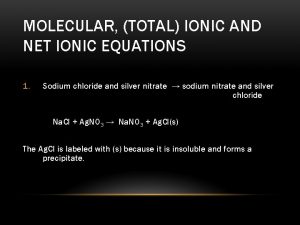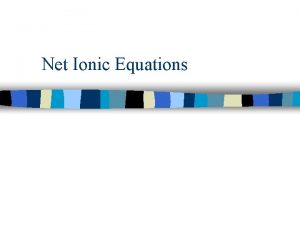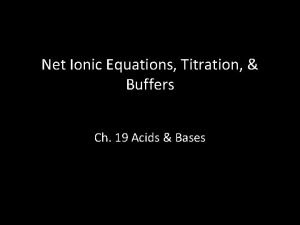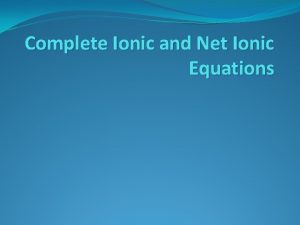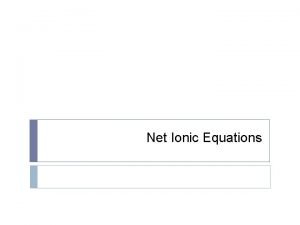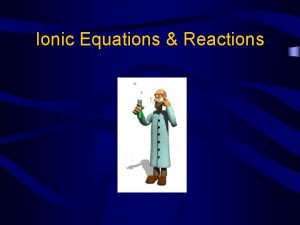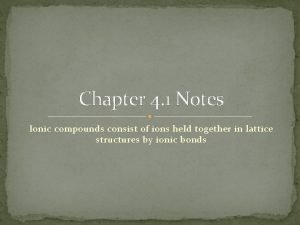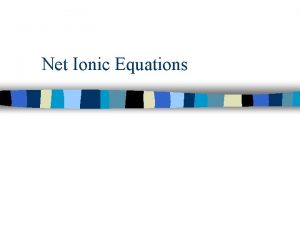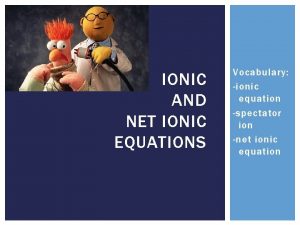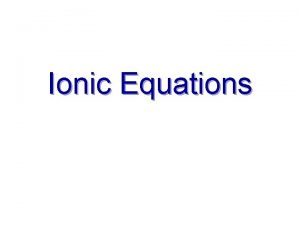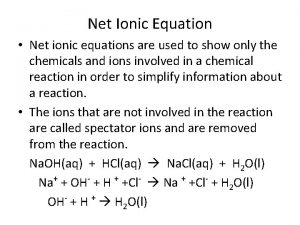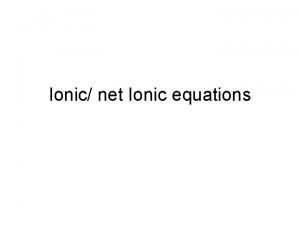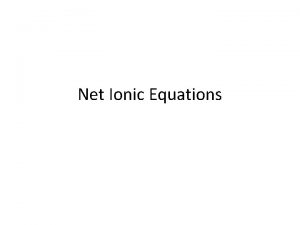Notes on Total and Net Ionic Equations Ionic














- Slides: 14

Notes on Total and Net Ionic Equations

Ionic Compounds (Metal and Nonmetal) (Cation and Anion) If soluble these compounds will DISSOLVE and DISSOCIATE (break apart into aqueous ions) Examples: Ca. Cl 2(aq) Ba(NO 3)2(aq) Ca+2(aq) Ba+2(aq) + 2 Cl-1(aq) + 2 NO 3 -1(aq)

Why write net-ionic equations? • To indicate the species actually involved in the chemical reaction.

For example, • Write the equation for the reaction of a solution of Ba. Cl 2 with a solution of Na 2 SO 4

Balance and ID the PPT ____Na 2 SO 4(aq) + ____Ba. Cl 2(aq) _____ Ba. SO 4 + _____ Na. Cl

Dissociate all aqueous compounds • Re-write the equation: 2 Na 1+(aq) + SO 42 -(aq) + Ba 2+(aq) + 2 Cl 1 -(aq) 2 Na 1+(aq) + 2 Cl 1 -(aq) + Ba. SO 4(s)

In writing a total ionic equation for reactions in water: We indicate all soluble ionic materials - substances that dissolve in water to form ions - as ions followed by (aq). All insoluble ionic solids are written with (s) following their formula

We then note that: Covalent compounds are written with their molecular formula. In this equation, we note that the sodium and chloride ions are unchanged and are present on both sides of the equation.

Since they are not undergoing chemical reaction, they can be referred to as spectator ions. • If we subtract the spectator ions from each side of the equation, we then have a net ionic equation

The net ionic equation for this reaction is: Ba 2+(aq) + SO 42 -(aq) Ba. SO 4(s) • The net ionic equation is a statement of the chemistry that occurred, namely, aqueous barium 2+ ion reacted with aqueous sulfate ion to form solid barium sulfate.

Net ionic equations may also be written for replacement reactions. • Write the equation for the double replacement reaction of aqueous potassium iodide with lead (II) nitrate solution.

Total ionic equation for double replacement reactions. • Write the total ionic equation for the same reaction

Net ionic equations may also be written for replacement reactions. • Write the net ionic equation for the reaction. • Cross off the Spectator Ions

Dissociate all aqueous compounds • Re-write the equation: Pb 2+(aq) + 2 I 1 -(aq) Pb. I 2(s) The nitrate ion doesn’t take part in the reaction so it is considered the spectator ion here.
 Molecular total and net ionic equations
Molecular total and net ionic equations Net inoic equation
Net inoic equation Acid base neutralization reaction
Acid base neutralization reaction How to write a complete ionic equation
How to write a complete ionic equation Complete ionic
Complete ionic Ions and ionic bonding cornell doodle notes
Ions and ionic bonding cornell doodle notes Uafir fórmula
Uafir fórmula Total revenues minus total costs equals
Total revenues minus total costs equals Total revenues minus total costs equals
Total revenues minus total costs equals Total revenues minus total costs equals
Total revenues minus total costs equals Total revenue minus total expenses
Total revenue minus total expenses Single replacement example
Single replacement example Total ionic equation example
Total ionic equation example Total ionic equation
Total ionic equation Concept 2 notes naming ionic compounds
Concept 2 notes naming ionic compounds
